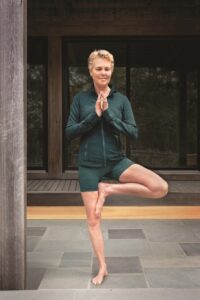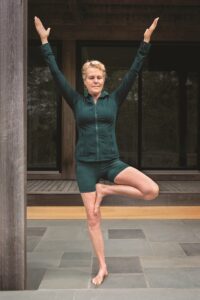If you are anything like me, you suddenly have many things you want to do — too many things. As summer begins, it is easy to become scattered. This is when I turn to my yoga practice for a pose that is grounding and settling. Tree Pose, Vrksasana, is particularly good for this. “Vrksa” means tree in Sanskrit, and I take the fact that there’s a pose named for it as a comfort: even in ancient India, long before cell phones and social media, people needed help getting grounded.
Start by standing with your hands in the gesture of prayer, anjali mudra, pressing your palms together in the center of your chest. One of many rituals of yoga, this one has the meaning of offering and often accompanies greetings and goodbyes. It is one you might see as way to return to your heart, to get yourself composed.

I like to do the Tree Pose on the bare floor, as I find it easier to balance there, rather than on a yoga mat, which has a little give. With your hands in the prayer pose, bring your awareness to your feet. Feel them making contact with the floor. Shift your weight into your right side and imagine you are growing roots down into the ground.
Now that you’re rooted on that side, begin to lift your left foot off the floor. Keep the right leg straight but don’t lock your knee; keep a subtle bend to it. Bring the sole of your left foot into the thigh of your right leg. Press the foot into the thigh and the thigh into the foot. Draw your navel into your spine and tuck your lower ribs in slightly. This helps to engage your core.
In this pose, you strengthen the core and legs. And you open the hips. It is, of course, also a challenging balance pose. It might help to stand near a wall so you can reach out and give yourself some extra support when needed. Or you could allow your knee or glutes to touch the wall.
If you are unable to bring your left leg all the way up to your thigh, you may modify the pose by placing your foot against the right calf or even against the ankle, with the toes and ball of the foot touching the floor, like a tripod or a kickstand. Just don’t place the foot against the knee, as that would put undue stress on the joint.
You may wobble; you may get frustrated. Have patience and a sense of humor. Be your own best friend as you do this, kind and encouraging.
Once in the pose, focus on a point on the floor in front of you. This is called a drishti point. Having a point to concentrate on helps to fix your attention. In this pose, I like to think of creating a third leg extending out through my eyes to the floor, helping to stabilize me.
Hold the pose for five to ten breaths, then lower the left foot and repeat on the other side.

If you would like to challenge yourself more, try lifting your arms up, either keeping the palms together or moving the arms apart in a wide “V” shape. Arms should be straight, so it is easier to do this with the arms apart. Make sure you keep your shoulders down, not hiked up near your ears. To make the pose even more challenging, try closing your eyes.
Whatever you do, let yourself have fun with it. You are challenging your proprioceptive system. This is how the body senses your movements and location in space and how you keep your balance. Sensory receptors in our joints, muscles, and skin work together to build body awareness. By practicing balance regularly, you help to strengthen and maintain this vital function.
This pose reminds me of what I love about yoga, something I hope will be part of a beautiful summer, which is that yoga works the whole person and so many aspects of what it is to be human. A simple pose like tree pose strengthens and opens the body. It increases our stability physically, emotionally, mentally, and if you will, spiritually.
Jennifer Shannon is a certified Kripalu yoga teacher on the Outer Cape.
